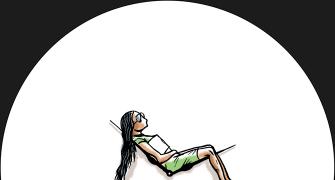Everything you need to know about the mental health disorder that led the actress to suicidal thoughts.

Photograph: @ileana_official/Instagram
Actress Ileana D'Cruz has openly discussed her battle with depression in the past, but she has now revealed that she also suffers from body dysmorphic disorder.
Sharing her mental health story in an advertisement of a denim brand she says, 'I was this very self-conscious, shy person once I hit my teens. So, I was constantly picked on for my body type. The obsession started when I was about 15; my entire goal was to make sure I was accepted by everyone. I think that is what I wanted the most. I never got it. I was always like the wallflower. I didn't even know I had a body disorder.
'So, when I started off with acting, it made things a little more worse.'
Ileana, who has seen two releases this year with Mubarakan and Baadshaho, confesses, 'There was a period, approximately three years ago, I'd go from happy to be completely depressed and not knowing what it was. The most comforting thought was, 'What if I just end things now.' And I thankfully released that this is not right.'
The first step to overcoming her depression and BDD, Ileana says, was acceptance.
'I never expected to be someone who'd be dealing with anxiety, dealing with depression. I've got every possible thing I could want,' she says. 'And I wondered, 'Why am I so depressed?' I still don't know sometimes. Then they told me you have depression, you have anxiety, you are going through body dysmorphic disorder. There was an acceptance which almost came immediately, and that I think is one of the biggest steps that you can take towards change. You can't move forward otherwise.'
She adds, 'You're human, you're not meant to be perfect. You're meant to be flawed. I'm just going to keep pushing and try and be the best of version that I can be of me.'
What is the meaning of body dysmorphic disorder?
According to the United Kingdom's National Health Service (NHS), 'Body dysmorphic disorder (BDD) is an anxiety disorder that causes a person to have a distorted view of how they look and to spend a lot of time worrying about their appearance. For example, they may be convinced that a barely visible scar is a major flaw that everyone is staring at, or that their nose looks abnormal.'
NHS clarifies, 'Having BDD does not mean the person is vain or self-obsessed.'
The Anxiety and Depression Association of America (ADAA) adds, ;BDD is a body-image disorder characterized by persistent and intrusive preoccupations with an imagined or slight defect in one's appearance. People with BDD can dislike any part of their body, although they often find fault with their hair, skin, nose, chest, or stomach. In reality, a perceived defect may be only a slight imperfection or nonexistent. But for someone with BDD, the flaw is significant and prominent, often causing severe emotional distress and difficulties in daily functioning.'
What are the causes of body dysmorphic disorder?
All experts concur that the causes of BDD are unclear.
ADAA notes, 'But certain biological and environmental factors may contribute to its development, including genetic predisposition, neurobiological factors such as malfunctioning of serotonin in the brain, personality traits, and life experiences (e.g. child maltreatment, sexual trauma, peer-abuse).'
What are the signs?
Dr Katharine Phillips, director of the BDD Program at Rhode Island Hospital and Professor of Psychiatry and Human Behavior at the Warren Alpert Medical School of Brown University in Rhode Island, lists the following symptoms on the International OCD Foundation (IOCDF) website:
- Frequent thoughts about appearance (at least an hour a day)
- Spending a lot of time staring in a mirror and/or reflective surface fixated on the flaw, or in some cases, a complete avoidance of mirrors/reflective surfaces
- Covering up the 'affected area' (for example, using hats, scarves, make-up)
- Repeatedly asking others to tell you that you look okay (also referred to as ‘reassurance seeking’)
- Frequent appointments with medical professionals/cosmetic surgeons
- Repeated plastic surgery
- Compulsive skin picking, which includes using fingernails and tweezers to remove blemishes and/or hair
- Avoiding social situations, public places, work, school, etc
- Leaving the house less often or only going out at night to prevent others from seeing the 'flaw'
- Keeping your obsessions and compulsions secret due to feelings of shame
- Emotional problems, such as feelings of disgust, depression, anxiety, low self-esteem, etc.
All experts warn that BDD can lead to depression, and thoughts of self-harm, even suicide.
Who can get body dysmorphic disorder?
Research reveals that BDD can affect men and women almost equally.
NHS adds, 'The condition can affect all age groups, but usually starts when a person is a teenager or a young adult, when people are generally most sensitive about their appearance.
'It's more common in people with a history of depression or social phobia. It often occurs alongside obsessive compulsive disorder (OCD) or generalised anxiety disorder, and may also exist alongside an eating disorder, such as anorexia or bulimia.'
BDD can impact people of all races and all socio-economic classes equally.
It is believed that BDD is significantly underdiagnosed and often misdiagnosed.
The ADAA explains, 'People with BDD commonly also suffer from anxiety disorders such as social anxiety disorder, as well as other disorders such as depression, eating disorders, or obsessive-compulsive disorder (OCD). BDD can also be misdiagnosed as one of these disorders because they share similar symptoms. The intrusive thoughts and repetitive behaviors exhibited in BDD are similar to the obsessions and compulsions of OCD.'
What is the treatment for BDD?
According to IOCDF, so far there are no blood tests, brain-scanning techniques, or other tools sufficient to diagnose BDD. A trained clinician does the diagnosis by asking questions to determine if the person fits the criteria.
ADAA says, 'Effective treatments are available to help BDD sufferers live full, productive lives.'
These include cognitive-behavioral therapy (CBT) and antidepressant medication.
'CBT teaches patients to recognize irrational thoughts and change negative thinking patterns. Patients learn to identify unhealthy ways of thinking and behaving and replace them with positive ones.'
Meanwhile, the medication 'can help relieve the obsessive and compulsive symptoms of BDD.'
Treatment is tailored to each patient.
How to cope with BDD?
Fortis Healthcare suggests the following:
Stick to your treatment plan. Don't skip therapy sessions, even if you don't feel like going.
Take your medications as directed. Even if you're feeling well, resist any temptation to skip your medications. If you stop, symptoms may come back. You could also experience withdrawal-like symptoms from stopping a medication too suddenly.
Learn about your condition. Education about BDD can empower you and motivate you to stick to your treatment plan.
Pay attention to warning signs. Work with your doctor or therapist to learn what might trigger your symptoms. Make a plan so you know what to do if symptoms return. Contact your doctor or therapist if you notice any changes in symptoms or how you feel.
Get active. Physical activity and exercise can help manage many symptoms, such as depression, stress and anxiety. Physical activity can also counteract the effects of some psychiatric medications that may cause weight gain.
Avoid drugs and alcohol. Alcohol and illegal drugs can worsen mental illness symptoms or interact with medications.
Write in a journal. This can help you express your pain, anger, fear or other emotions.
Don't become isolated. Try to participate in normal activities and get together with family or friends regularly.
Take care of yourself. Eat healthy, stay physically active and get sufficient sleep.
Read reputable self-help books. Consider talking about them to your doctor or therapist.
Join a support group. Connect with others facing similar challenges.
Stay focused on your goals. Recovery is an ongoing process. Stay motivated by keeping your recovery goals in mind.
Learn relaxation and stress management. Try such stress-reduction techniques as meditation, yoga or tai chi.
Don't make important decisions when you're feeling despair or distress. You may not be thinking clearly and may regret your decisions later.
Recommended for you: The list of celebrities who struggled with depression is long










